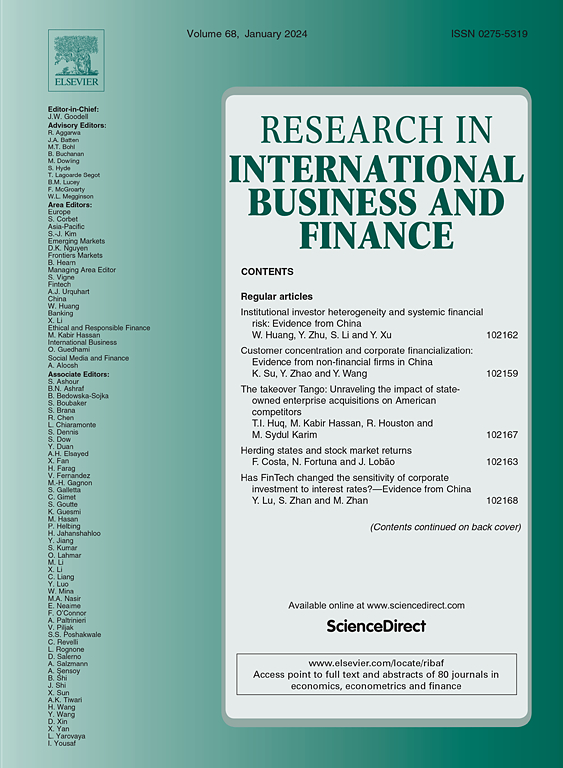欧洲银行的息差和货币政策:粘性现象的证据
IF 6.9
2区 经济学
Q1 BUSINESS, FINANCE
Research in International Business and Finance
Pub Date : 2025-07-01
DOI:10.1016/j.ribaf.2025.103073
引用次数: 0
摘要
本文通过分析194家银行从2021Q1到2023Q3的息差及其组成部分的变化,考察了欧洲货币政策的流动性传导。分析显示,各银行对欧洲央行上调主要再融资操作利率的反应总体迅速。然而,这种调整是不对称的,对利息支出的影响比对利息收入的影响更小、更慢,从而导致粘性现象。进一步的分析表明,粘性效应在效率较低的环境中更为明显(例如,以银行为中心的国家,由小银行组成,成年人的金融知识水平较低)。总体研究结果表明,欧洲银行的反应在不影响欧洲央行冲动传递的情况下,将货币紧缩对其损益表的有利影响最大化。更有效的欧洲市场同质化,可以统一对货币政策的反应,在欧盟内部创造公平的竞争环境。本文章由计算机程序翻译,如有差异,请以英文原文为准。
European banks’ interest margins and monetary policy: Evidence of a stickiness phenomenon
This paper examines the liquidity transmission of European monetary policy by analyzing the changes in interest margins and their components for 194 banks from 2021Q1 to 2023Q3. The analysis shows an overall prompt response by banks to the rise in the ECB's main refinancing operations rate. However, this adjustment is asymmetrical, affecting interest expenses less and more slowly than interest income, thereby leading to a stickiness phenomenon. Further analyses reveal that the stickiness effect appears more pronounced in less efficient settings (e.g., bank-centric countries, populated by small banks and with low degree of financial literacy among adults). The overall findings suggest that the reaction of European banks maximises the beneficial effects of the monetary tightening on their income statements without compromising the pass-through of the ECB impulse. A more effective homogenization of the European markets could uniformise the response to monetary policy, levelling the playing field within the Union.
求助全文
通过发布文献求助,成功后即可免费获取论文全文。
去求助
来源期刊

Research in International Business and Finance
BUSINESS, FINANCE-
CiteScore
11.20
自引率
9.20%
发文量
240
期刊介绍:
Research in International Business and Finance (RIBAF) seeks to consolidate its position as a premier scholarly vehicle of academic finance. The Journal publishes high quality, insightful, well-written papers that explore current and new issues in international finance. Papers that foster dialogue, innovation, and intellectual risk-taking in financial studies; as well as shed light on the interaction between finance and broader societal concerns are particularly appreciated. The Journal welcomes submissions that seek to expand the boundaries of academic finance and otherwise challenge the discipline. Papers studying finance using a variety of methodologies; as well as interdisciplinary studies will be considered for publication. Papers that examine topical issues using extensive international data sets are welcome. Single-country studies can also be considered for publication provided that they develop novel methodological and theoretical approaches or fall within the Journal''s priority themes. It is especially important that single-country studies communicate to the reader why the particular chosen country is especially relevant to the issue being investigated. [...] The scope of topics that are most interesting to RIBAF readers include the following: -Financial markets and institutions -Financial practices and sustainability -The impact of national culture on finance -The impact of formal and informal institutions on finance -Privatizations, public financing, and nonprofit issues in finance -Interdisciplinary financial studies -Finance and international development -International financial crises and regulation -Financialization studies -International financial integration and architecture -Behavioral aspects in finance -Consumer finance -Methodologies and conceptualization issues related to finance
 求助内容:
求助内容: 应助结果提醒方式:
应助结果提醒方式:


